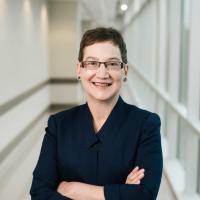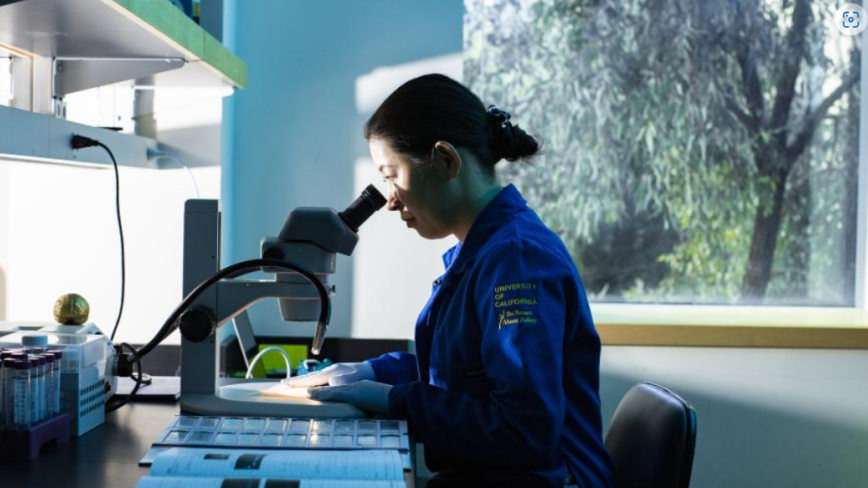Dairy cows in California have a new requirement meeting them: a negative test for H5n1 or “bird flu.”
These tests are handled by the California Animal Health and Food Safety Laboratory System – the backbone of California's warning system that helps to protect the health of California's livestock and, thereby, the lives of Californians.
Through a partnership between the UC Davis School of Veterinary Medicine and the California Department of Food and Agriculture, the California Animal Health and Food Safety Laboratory System (CAHFS) program is a safeguard for public health. With locations in Davis, Turlock, Tulare and San Bernardino – each strategically located to meet the agriculture industry needs of the surrounding area – the program provides quality services, like H5N1 testing, intended to protect animal health and performance, public health and California’s food supply.
Veterinarians as state partners and first-line responders in pandemic response
Bird flu is not the first zoonotic disease to significantly alter the public health landscape, nor will it be the last. Salmonella. Zika. COVID-19 –these recent and ongoing pandemics emphasize that zoonotic disease threats are ever-present and carry a growing risk not just to animal health, but to global public health.
That’s why the UC Davis One Health approach guides the work of the nation’s #1 veterinary school. One Health “recognizes the interconnectedness of animal, human, and environmental health” and is essential in addressing global diseases while advancing the health and conservation of our ecosystem.

Veterinary professionals and researchers are at the forefront of addressing and studying zoonotic diseases. By adopting a transdisciplinary One Health approach, we understand the interconnectedness of animal, human, and environmental health. As global health challenges grow, UC Davis will remain a vital partner — partnering with California agencies, local farmers and more — to promote the well-being of animals, people and our shared planet.
UC is a partner in local, state, national and global pandemic preparedness research
Predicting and preparing for the next public health emergency started during the last one. And has been made possible through regular collaborative, collective action.
In 2020, in coordination with the city of San Francisco and the state of California, UCSF launched the Center for Pandemic Preparedness and Response (CPPR). The center was created to address pandemics at both local and global scales, focusing on enhancing readiness, response, and resilience against significant health threats. Currently, while continuing its pandemic response initiatives, UCSF CPPR has broadened its scope to adopt a One Health approach, emphasizing the importance of collaboration across various sectors—human, environmental, animal, and agricultural—to mitigate disease threats.
Fast-forward two years in 2022, and teams of researchers from UC Davis, UCLA and UC San Diego received U.S. National Science Foundation (NSF) grants as part of a new NSF Predictive Intelligence for Pandemic Prevention (PIPP) program. This program is designed to support the development of centers that work to predict the emergence and spread of the next pandemic.
Just recently, in August 2024, the U.S. National Science Foundation (NSF) announced the awards for the next phase in the PIPP program, which establishes the Center for Pandemic Insights (CPI), led by UC Davis and in partnership with ten other institutions, including UCLA and UC San Diego. Backed by $18 million over seven years, the goal of the NSF CPI is to leverage emerging technologies and enhance detection methods to identify, study, and ultimately inform pandemic prevention efforts worldwide.
“The NSF Center for Pandemic Insights is a moonshot for being able to transform how we do investigations into the pre-emergence phase for pandemics. We’ll be able to optimize cutting-edge technology that’s already being applied in areas of human health, engineering and agriculture and bring them into this important space to help with wildlife and pandemic threats,” added center lead Christine K. Johnson, a professor of epidemiology and ecosystem health in the UC Davis School of Veterinary Medicine and director of the EpiCenter for Disease Dynamics in the One Health Institute.
Looking back at COVID-19 to prepare for future pandemics
The University of California is clearly no stranger to navigating pandemics. With roughly 300,000 students, more than 240,000 employees, and home to one of the country's largest public academic health systems, the UC system was nationally viewed as a leader in COVID-19 response.
That’s why, to prepare for future public health emergencies, the former UC Health Executive Vice President, Carrie L. Byington, M.D., has been working with UC leaders across the system to capture the collective action efforts that UC took to combat the COVID-19 pandemic. The report “Connected: Lessons from the University of California Systemwide COVID-19 Response” is expected to be published next month. It will contain information on the vast systemwide strategies that support the health of UC employees, students, patients, and California communities.

The Connected report is written for those in the future who will face new threats to public health. It is not a question of if, but when, the next public health emergency or pandemic will threaten our well-being. Across UC, we learned that leadership matters. The willingness to act early drove better public health outcomes and broad collaborations amplified and disseminated the work of the system across the state.
Collaborations in the wake of COVID-19 took many forms. For example, UC San Diego Health partnered with the San Diego County Health Department and the Padres professional baseball team to establish a vaccine superstation at the Petco Park Major League Baseball (MLB) stadium with the City of San Diego. This partnership provided vaccines to hundreds of thousands of residents in the San Diego area, including health care workers and other essential employees. The model of using an MLB stadium as a vaccine center was replicated throughout the nation, with more than 1 million vaccine doses administered in ballparks from January through March 2021.
UC hospitals delivered high-quality care with some of the lowest mortality rates in the U.S. The academic health centers and campus locations developed capacities for remote health visits and virtual learning. When more in-person work and education began, UC experienced no outbreaks that required curtailing or closing locations. Our facilities were not superspreaders in the surrounding communities. Research flourished as investigators pivoted to questions about the pandemic, and National Institutes of Health grant funding increased by 25 percent.
The report, “Connected: Lessons from the University of California Systemwide COVID-19 Response,” will be a playbook for setting up public health emergency management and mitigation strategies, helping inform UC’s response to future pandemics.
Editors note as of 11/15/2024: the "Connected: Lessons from the University of California Systemwide COVID-19 Response" report is now available.
About University of California Health
University of California Health comprises six academic health centers, 21 health professional schools, a Global Health Institute and systemwide services that improve the health of patients and the University’s students, faculty and employees. All of UC’s hospitals are ranked among the best in California and its medical schools and health professional schools are nationally ranked in their respective areas.

